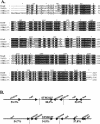SseK1 and SseK2 are novel translocated proteins of Salmonella enterica serovar typhimurium
- PMID: 15322005
- PMCID: PMC517430
- DOI: 10.1128/IAI.72.9.5115-5125.2004
SseK1 and SseK2 are novel translocated proteins of Salmonella enterica serovar typhimurium
Abstract
Salmonella enterica is a gram-negative, facultative intracellular pathogen that causes disease symptoms ranging from gastroenteritis to typhoid fever. A key virulence strategy is the translocation of bacterial effector proteins into the host cell, mediated by the type III secretion systems (TTSSs) encoded in Salmonella pathogenicity island 1 (SPI-1) and SPI-2. In S. enterica serovar Typhimurium LT2, we identified the protein products of STM4157 and STM2137 as novel candidate secreted proteins by comparison to known secreted proteins from enterohemorrhagic Escherichia coli and Citrobacter rodentium. The STM4157 and STM2137 proteins, which we have designated SseK1 and SseK2, respectively, are 61% identical at the amino acid level and differ mainly in their N termini. Western analysis showed that in vitro accumulation and secretion of these proteins in serovar Typhimurium were affected by mutations in the two-component systems SsrA/B and PhoP/Q, which are key mediators of intracellular growth and survival. SPI-2 TTSS-dependent translocation of recombinant SseK1::Cya was evident at 9 h postinfection of epithelial cells, while translocation of SseK2::Cya was not detected until 21 h. Remarkably, the translocation signal for SseK1 was contained within the N-terminal 32 amino acids. Fractionation of infected epithelial cells revealed that following translocation SseK1 localizes to the host cytosol, which is unusual among the currently known Salmonella effectors. Phenotypic analysis of DeltasseK1, DeltasseK2, and DeltasseK1/DeltasseK2 mutants provided evidence for a role that was not critical during systemic infection. In summary, this work demonstrates that SseK1 and SseK2 are novel translocated proteins of serovar Typhimurium.
Figures





Similar articles
-
SseL is a salmonella-specific translocated effector integrated into the SsrB-controlled salmonella pathogenicity island 2 type III secretion system.Infect Immun. 2007 Feb;75(2):574-80. doi: 10.1128/IAI.00985-06. Epub 2006 Dec 11. Infect Immun. 2007. PMID: 17158898 Free PMC article.
-
Type III secretion of the Salmonella effector protein SopE is mediated via an N-terminal amino acid signal and not an mRNA sequence.J Bacteriol. 2005 Mar;187(5):1559-67. doi: 10.1128/JB.187.5.1559-1567.2005. J Bacteriol. 2005. PMID: 15716426 Free PMC article.
-
Genetic and molecular analysis of GogB, a phage-encoded type III-secreted substrate in Salmonella enterica serovar typhimurium with autonomous expression from its associated phage.J Mol Biol. 2005 May 13;348(4):817-30. doi: 10.1016/j.jmb.2005.03.024. J Mol Biol. 2005. PMID: 15843015
-
Bacteriophage-encoded type III effectors in Salmonella enterica subspecies 1 serovar Typhimurium.Infect Genet Evol. 2005 Jan;5(1):1-9. doi: 10.1016/j.meegid.2004.07.004. Infect Genet Evol. 2005. PMID: 15567133 Review.
-
Salmonella-containing vacuoles: directing traffic and nesting to grow.Traffic. 2008 Dec;9(12):2022-31. doi: 10.1111/j.1600-0854.2008.00827.x. Epub 2008 Oct 8. Traffic. 2008. PMID: 18778407 Review.
Cited by
-
The impact of sseK2 deletion on Salmonella enterica serovar typhimurium virulence in vivo and in vitro.BMC Microbiol. 2019 Aug 7;19(1):182. doi: 10.1186/s12866-019-1543-2. BMC Microbiol. 2019. PMID: 31390974 Free PMC article.
-
A comprehensive study of the contribution of Salmonella enterica serovar Typhimurium SPI2 effectors to bacterial colonization, survival, and replication in typhoid fever, macrophage, and epithelial cell infection models.Virulence. 2011 May-Jun;2(3):208-16. doi: 10.4161/viru.2.3.15894. Epub 2011 May 1. Virulence. 2011. PMID: 21540636 Free PMC article.
-
Tubulin Folding Cofactor TBCB is a Target of the Salmonella Effector Protein SseK1.Int J Mol Sci. 2020 Apr 30;21(9):3193. doi: 10.3390/ijms21093193. Int J Mol Sci. 2020. PMID: 32366039 Free PMC article.
-
SseK3 Is a Salmonella Effector That Binds TRIM32 and Modulates the Host's NF-κB Signalling Activity.PLoS One. 2015 Sep 22;10(9):e0138529. doi: 10.1371/journal.pone.0138529. eCollection 2015. PLoS One. 2015. PMID: 26394407 Free PMC article.
-
NleB/SseK effectors from Citrobacter rodentium, Escherichia coli, and Salmonella enterica display distinct differences in host substrate specificity.J Biol Chem. 2017 Jul 7;292(27):11423-11430. doi: 10.1074/jbc.M117.790675. Epub 2017 May 18. J Biol Chem. 2017. PMID: 28522607 Free PMC article.
References
-
- Anderson, D. M., and O. Schneewind. 1997. A mRNA signal for the type III secretion of Yop proteins by Yersinia enterocolitica. Science 278:1140-1143. - PubMed
-
- Bajaj, V., C. Hwang, and C. A. Lee. 1995. HilA is a novel OmpR/ToxR family member that activates the expression of Salmonella typhimurium invasion genes. Mol. Microbiol. 18:715-727. - PubMed
-
- Bajaj, V., R. L. Lucas, C. Hwang, and C. A. Lee. 1996. Co-ordinate regulation of Salmonella typhimurium invasion genes by environmental and regulatory factors is mediated by control of hilA expression. Mol. Microbiol. 22:703-714. - PubMed
-
- Brumell, J. H., S. Kujat-Choy, N. F. Brown, B. A. Vallance, L. A. Knodler, and B. B. Finlay. 2003. SopD2 is a novel type III secreted effector of Salmonella typhimurium that targets late endocytic compartments upon delivery into host cells. Traffic 4:36-48. - PubMed
Publication types
MeSH terms
Substances
LinkOut - more resources
Full Text Sources
Miscellaneous

